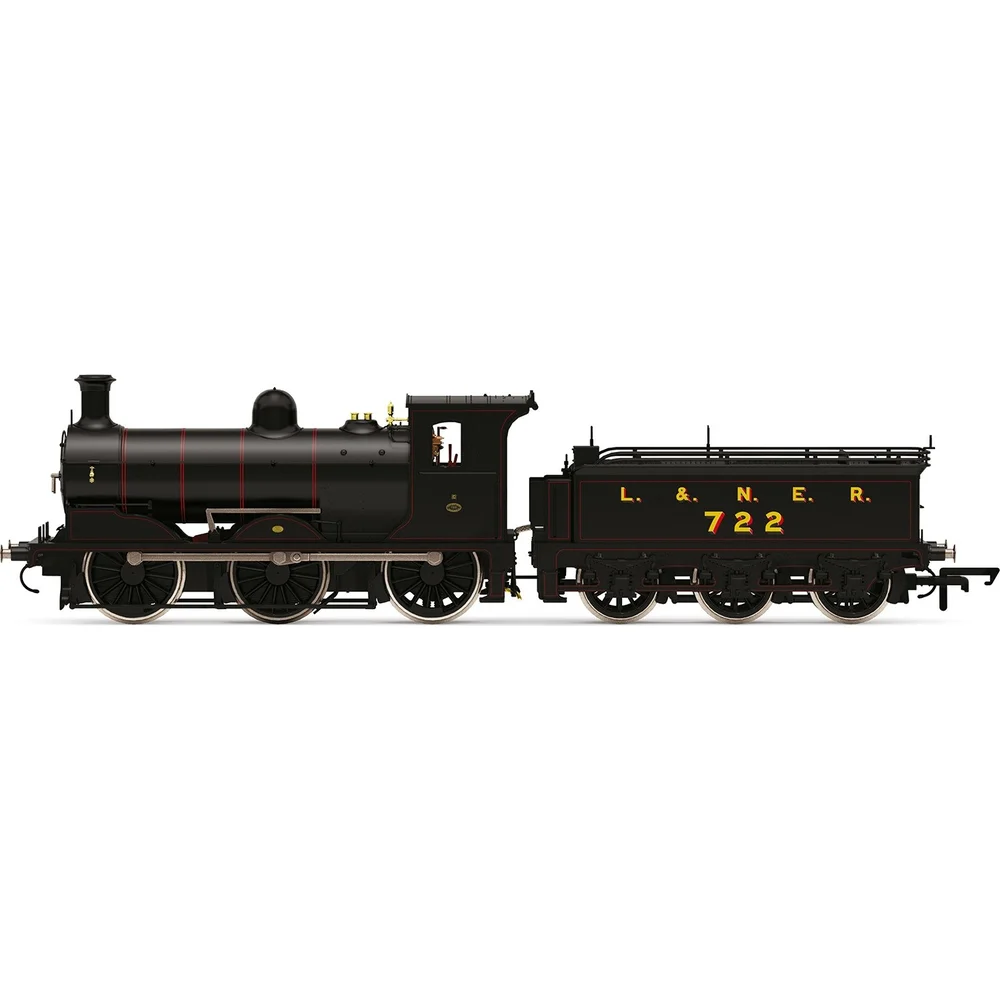Hornby R3621
London & North Eastern Railway J36 722 London & North Eastern Railway Lined Black
Class & Prototype
- Class: London & North Eastern Railway J36
- Traction: Steam
- Built: 1888-1901
- Total Built: 168
- Running Number: 722
- Ordered By: North British Railway
- Built By: North British Railway
- Built At: Cowlairs
- Built: 06/1897
- Withdrawn: 11/1962
- Length of Service: 65.4 years
- Running Numbers: NBR 722, LNER 9722, LNER 5293, BR 65293
- Names: -
The NBR C Class (LNER J36) was a class of 168 robust 0-6-0 freight locomotives designed by Matthew Holmes and introduced in 1888 for the North British Railway. Known as the "Eighteen Inchers" due to their unusually large 18-inch cylinders, these locomotives became Scotland's most enduring steam design, with 123 examples surviving into British Railways ownership. Twenty-five served with distinction in France during WWI, returning with commemorative battle names. Rebuilt with larger boilers between 1913-1923, they adapted from freight work to mixed traffic duties, ultimately becoming the last steam locomotives in regular service in Scotland when withdrawn in June 1967. Their 79-year service record and operational versatility make them ideal prototypes for Scottish-themed model railways spanning the steam era's final decades.
Operator & Livery
- Operator: London & North Eastern Railway
- Livery: Lined Black
- Era: 3 - The big 4 – LMS, GWR, LNER & SR
The London & North Eastern Railway emerged in 1923 as Britain's second-largest railway company, combining seven major railways including the Great Northern, North Eastern, and Great Eastern into a 6,590-mile network stretching from London's four terminals to the Scottish Highlands. Despite serving economically challenged industrial regions, the LNER achieved worldwide recognition for engineering excellence and speed records that remain unbroken today.
Under Chief Mechanical Engineers Sir Nigel Gresley, Edward Thompson, and Arthur Peppercorn, the LNER developed revolutionary locomotive designs characterised by three-cylinder layouts and streamlined aesthetics. Gresley's masterpieces included the A1 Pacifics featuring Flying Scotsman and the legendary A4 class, culminating in Mallard's world steam speed record of 126 mph in 1938.
The company pioneered luxury express services including the Silver Jubilee and Coronation streamliners, whilst investing in forward-thinking electrification schemes and massive marshalling yards. Notable achievements included operating the complete East Coast Main Line, introducing Britain's first regular 400-mile non-stop service, and commissioning Eric Gill's iconic typography that influenced railway design for decades.
Nationalised in 1948, LNER locomotives continued serving British Railways until the 1960s, with some A4 Pacifics working Scottish expresses until 1966. Today, the LNER's engineering legacy thrives through extensive preservation, new-build projects like Tornado, and comprehensive model ranges covering every major class in all popular scales, making LNER subjects essential for discerning railway modellers seeking authentic British steam-age atmosphere.
The LNER lined black livery represented the company's commitment to aesthetic excellence across all locomotive types during the early period of its existence. Introduced from 1923, this elegant scheme adorned freight engines and secondary passenger locomotives with distinctive red lining that transformed utilitarian workhorses into smart, professionally finished machines. The red lines were carefully applied to running plates, boiler bands, and cab panels, following the locomotive's mechanical contours and emphasising engineering features whilst maintaining the practical benefits of a dark base colour for heavy-duty operations.
Distinctive features of this livery included yellow lettering and numbering with red shading (contrasting with the gold used on prestigious green passenger locomotives), and "L N E R" applied in full to tenders. The lined black scheme demonstrated the LNER's philosophy that even freight locomotives deserved visual dignity and corporate identity. However, economic pressures forced changes to this refined approach: red lining was removed from goods engines as an economy measure in 1928, though secondary passenger locomotives retained their lined finish until 1941. For model railway enthusiasts, this livery perfectly captures the LNER's early optimism and attention to detail, making it ideal for depicting 1920s freight operations, mixed-traffic locomotives, and the period when the newly-formed company took pride in presenting a cohesive, quality image across its entire 6,300-locomotive fleet.
